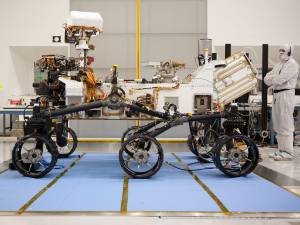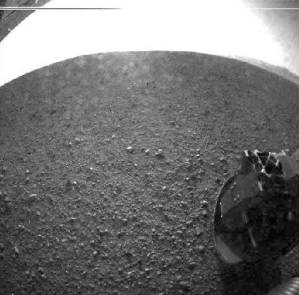 'This mission has been in the works for 10 years. If it is successful it will be one of the greatest engineering feats of mankind,' declared Museum scientist Joseph Michalski shortly before that feat was pulled off with aplomb in the early hours of today. As NASA's Curiosity rover beamed back its first image from the surface of Mars it was 06:14 BST, but it was only after a 14 minute-long journey via the Mars Odyssey orbiter, Canberra's Deep Space Network, and California's Mission Control, that it reached the large screen of our Mars Landing special event in the Museum's Flett Theatre.
'This mission has been in the works for 10 years. If it is successful it will be one of the greatest engineering feats of mankind,' declared Museum scientist Joseph Michalski shortly before that feat was pulled off with aplomb in the early hours of today. As NASA's Curiosity rover beamed back its first image from the surface of Mars it was 06:14 BST, but it was only after a 14 minute-long journey via the Mars Odyssey orbiter, Canberra's Deep Space Network, and California's Mission Control, that it reached the large screen of our Mars Landing special event in the Museum's Flett Theatre.
The elated joy visible on screen at Mission Control was immediately mirrored by the eruption of cheers and applause from our audience. The relief was palpable, particularly as half of the previous missions to Mars have ended in failure; Michael Balme, panellist and - like Joe - one of the team of international scientists who worked on the mission, would later sum up the morning with, 'I expected the worst but hoped for the best, so today is now going to be like Christmas!'
Of the 7 minutes of terror during EDL (entry, descent and landing), if anything was going to go wrong it was the very last moments of the L as this was when an entirely new and untried mechanism for deploying a payload onto a planet's surface was put to the test. Although airbags had been hugely successful for Spirit and Opportunity in 2004, the near 900kg of Curiosity made the same approach highly impractical; instead, the brain-storming at NASA had produced 'sky crane', which Joseph described perfectly following the landing as something that '... looks bonkers, but it worked!'
From an altitude of tens of metres above the surface, this mechanism winched the Curiosity rover from its rocket-powered, hovering landing cradle gently onto the surface. In a very British style, Matthew Balme put it as, '... something you would call very Heath Robinson,' or, to paraphrase a tweet that flashed past on my phone at the same time, 'if you had put this crazy idea for a landing in a hollywood script, you would have been laughed out of the studio'.
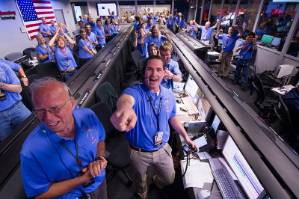 Thankfully, NASA's team of engineers did Heath Robinson and the rest of us proud and Curiosity has started its Martian-year-long mission (equvialent to about 2 Earth years) with great success. The first black-and-white 64x64 pixel thumbnail image and, soon after, the sharper 256x256 pixel version announced its perfect landing on the anticipated flat, slightly gravelly surface.
Thankfully, NASA's team of engineers did Heath Robinson and the rest of us proud and Curiosity has started its Martian-year-long mission (equvialent to about 2 Earth years) with great success. The first black-and-white 64x64 pixel thumbnail image and, soon after, the sharper 256x256 pixel version announced its perfect landing on the anticipated flat, slightly gravelly surface.
These were closely followed by shots of its wheel and shadow on the same, and the end of the beginning for this multi-billion dollar adventure was reached. Sadly for our audience, Martian time prevented more than this handful of snapshots being captured during our event as Odyssey promptly disappeared over the Martian horizon and thus the link back to Earth was lost until its next pass over the region some hours later.
At this point, our extremely relieved panel of mission scientists and Mars experts started to take questions from the audience. These ranged from the planning behind the mission to the future of Mars and space exploration. Panellist Peter Grindrod had the onerous task of trying to follow the excitement of the landing and did an admirable job.
He first explained how sky crane had permitted the EDL team to target a much smaller landing area than those of previous missions. The huge benefit of this focussed, and very gentle landing of a large rover was the amount of scientific equipment it could carry to the surface (his slide below helps put that in true perspective - the rover is huge).
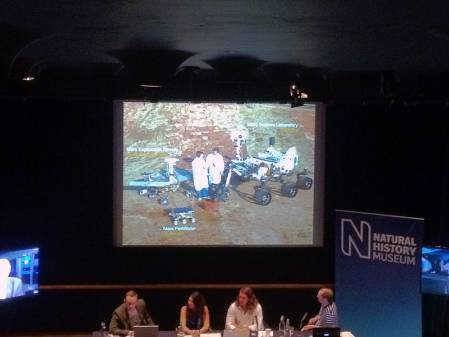 Peter Grindrod's slide of the different rovers that have made it to Mars. Curiosity is on the right.
Peter Grindrod's slide of the different rovers that have made it to Mars. Curiosity is on the right.
Further prompting from the audience led him to describe how Gale Crater had been chosen as the target for the mission - it was the combination of all the characteristics they were looking for, topographical, geological and chemical, that carried the day for Gale Crater although another 3 very good contenders had been shortlisted following an approximately 6 year-long selection process. It also happened to be Peter's favourite choice, 'I can only imagine the view Curiosity must have now.'
He then described in brief each of the 10 instruments on board, including the X-ray spectrometer (the first to be deployed on another planet) that will analyse samples collected from drilling a few centimetres below the surface. 'Context is key for geological analysis,' and so the ability to pick locations and drive the rover to them forms an important part of the mission. At this point, Joe chipped in with 'some sort of organic material would be excellent to discover,' which led Peter to state that, as with all previous missions, it is the things that the planners haven't anticipated that will prove the most exciting aspect of the mission.
More questions and more responses from all of the panellists followed, including a great fly-over of Gale Crater in Google Earth (that is, the Mars version) from Matthew to show the geology of the landing area and crater. These taught us that Gale will be an exemplar for many other locations on Mars as similar sedimentary rock formations have been observed elsewhere on the planet. Matthew and Joe told us how the landing area was a compromise between the demands of the scientists ('we want interesting and varied topography and geology - the equivalent of the Grand Canyon!') versus the engineers ('we want flat, boring and windless!').
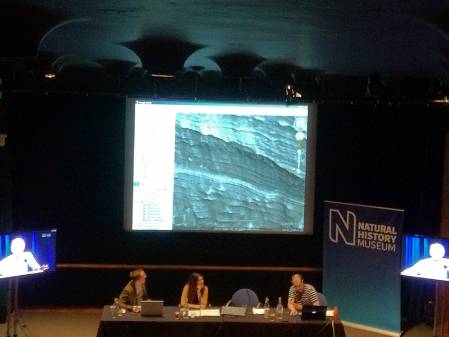 Matthew Balme shows imagery of Gale Crater on Mars captured by the Mars Reconnaissance Orbiter
Matthew Balme shows imagery of Gale Crater on Mars captured by the Mars Reconnaissance Orbiter
Joe described how the marginally smaller size of Mars relative to Earth is a possible explanation for why it doesn't experience any plate tectonics - incidentally, Earth is the only planet in our solar system that does - which is a good reason for going there to study it (we don't have access to any truly ancient rocks here on Earth due to the churn and change that our heated core causes at the surface).
The mound in the centre of the impact-generated Gale Crater was, according to Peter, probably there because it was once infilled, and erosion has cleared the surrounding basin while leaving the central peak preserved. This means the base of the mound is the old geology, the top the relatively new. And, of course, the tantalising evidence of previous water flow and clay formation as the principal reason for choosing Gale Crater featured heavily in the discussion as it is this that makes it ideal for the search for a potentially once-habitable environment.
A few of the many great questions from the audience are worth highlighting here (I've summarised the replies):
Q: 'Why haven't probes sent to Mars looked for life since the Viking missions [in the 1970s]?'
A: Because of the likelihood that very few locations will have any evidence of life. We have to first discover where could there have been life before we ask is there life and we have to be patient. Therefore Curiosity is looking for habitats that could have supported life rather than life itself.
Q: 'How long will the mission last'
A: It is guaranteed funding for one Martian year but, due to its nuclear power source, it could go on for many, many years if the instrumentation remains working and is still returning useful data. [N.B. Spirit and Opportunity were originally funded for a 90 day mission as their solar panels were expected to clog up with dust and cease functioning; in reality they lasted 8 years as the wholly unexpected benefit of dust devils on the Martian surface periodically cleaned the panels enabling them to keep charged for far longer than anticipated].
Q: 'What will happen to Opportunity now that Curiosity has landed safely?'
A: Opportunity has taken a lower priority for obvious reasons, but its mission will keep going for as long as it sends back useful data and the funding is there [N.B. Spirit got stuck in a location that meant it could no longer charge and it lost power, thus effectively ending its mission earlier].
During the post-landing Q and A we also had the pleasure of linking-live for a few minutes to the boisterous Jet Propulsion Laboratory in Pasadena, California to talk with Dr Derby Dyer who worked on Curiosity's ChemCam instrument. She and her colleagues were walking around with big smiles on their faces, and not because of the cookies that had just been deployed in their office at that moment:
Q: 'What would have happened if the weather conditions hadn't been ideal for landing? Could the mission have been aborted?'
A: The landing was autonomous so we couldn't have aborted or changed it. However, the weather has been modelled for weeks in advance - if we had spotted potential issues a few weeks ago, we could have made a slight alteration to the landing schedule but there wasn't a lot of leeway.
Q: 'What would you recommend someone does to get involved in this type of project'
A: Learn how to be a critical thinker! Go to College [University] and be passionate about the science.
We were also joined by Ralph Cordey of Astrium, to talk about future missions to Mars. Astrium's prototype rover for the next major trip to Mars, the European ExoMars mission in 2018, was on display at the Museum today. Ralph explained how the Curiosity mission already contained a European element as it invovles the ESA's Mars Express as one of the orbiters capturing the data from Curiosity for transmission back to Earth.
For ExoMars, there are currently three prototypes of the rover: BRIDGET (Ralph believes it may be named after Bridget Bardot), BRUNO - which is being tested in Stevenage - and BRADLEY (Italy). The final rover will be smaller than Curiosity but will be designed to drill up to 2 metres below the Martian surface and look for biomarkers.
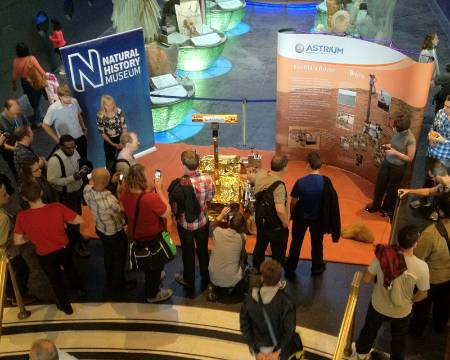 Members of the audience enjoy their look at BRIDGET, Astrium's prototype Mars rover
Members of the audience enjoy their look at BRIDGET, Astrium's prototype Mars rover
However, that mission is still to come, and from today we are looking forward to the first real results from Curiosity's in-built science lab and (hopefully) the excitement of seeing photos of its descent to the planet and video of the sky crane deployment as shot from the landing module. But, as must be the case with a 10 year long project, we will need to be patient over the next few days as all this data can't be sent at once and NASA's priority now is to perform tests to make sure everything is functioning as expected. That just leaves me to quote my favourite tweet from earlier today:
@Paul_Cornell: As Eugene Byrne put it: 'The nerds just took Gold in the 560 billion metres'
View NASA's multimedia gallery from the Curiosity mission
Follow @MarsCuriosity on Twitter
Find out more about our After Hours events
Image rights:
After Hours Mars Landing event photos, Natural History Museum
Curiosity's surroundings, NASA/JPL-Caltech
JPL Mission Control, NASA HQ PHOTO



